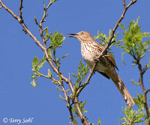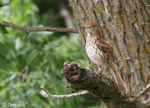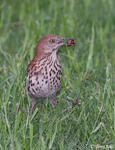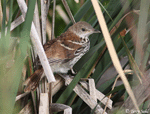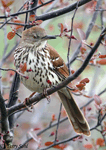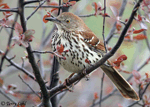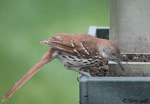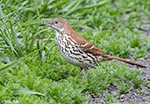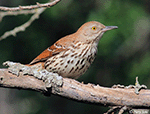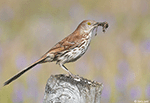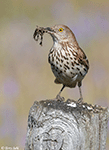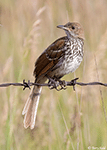| Length: 11.5 inches | Wingspan: 14 inches | Seasonality: Summer |
| ID Keys: Rufous brown upperparts, white heavily streaked underparts, 2 white wing bars | ||
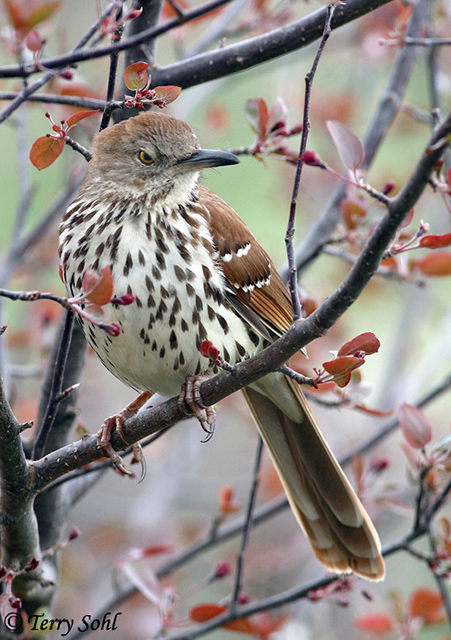 Brown
Thrashers are shy birds of woodland
edges and thickets, usually rushing for cover at approach. However, they
can often been seen singing from a high, conspicuous perch at the start of the
breeding season. Like others of
the family Mimidae (the family including Mockingbirds), the Brown Thrasher will
occasionally mimic the songs of other birds. They are thought to have the
richest vocabulary of any bird in North America.
Brown
Thrashers are shy birds of woodland
edges and thickets, usually rushing for cover at approach. However, they
can often been seen singing from a high, conspicuous perch at the start of the
breeding season. Like others of
the family Mimidae (the family including Mockingbirds), the Brown Thrasher will
occasionally mimic the songs of other birds. They are thought to have the
richest vocabulary of any bird in North America.
Habitat:
Forest edges and clearings, brushy fields, thickets, residential shrubs and hedges.
Diet:
Insects, crustaceans, lizards, amphibians, earthworms, fruits and berries, nuts, and seeds.
Behavior:
Does most of its foraging on the ground, hopping about looking for food, or flipping over leaves and small stones in search of insects. Will also feed in trees and shrubs, especially when feeding on fruit and nuts.
Nesting:
May through July in South Dakota. The nest of a Brown Thrasher is a large bulky cup, constructed of twigs, weed stems, strips of bark, leaves, and other vegetative material, lined with fine grasses. Both the male and female help construct the nest. The female lays between 2 and 6 eggs and both parents help to incubate them. The young hatch after about 13 days, fledging from the nest 10-13 days after hatching.
Song:
Long series of distinct phrases, with each generally given in pairs before moving on to the next phrase. Brown Thrashers have an incredibly diverse set of vocalizations, with phrases and songs differing between individual birds, or even a single bird frequently changing its song. They also have a variety of shorter calls.
- Click here to hear the song of a Brown Thrasher1
- Click here to hear the short smacking call of a Brown Thrasher2
- Click here to hear another song of a Brown Thrasher3
Migration:
Northern populations (including those in South Dakota) move south in the fall. Most winter in the southeastern United States.
Interactive eBird Map:
Click here for access to an interactive eBird map of Brown Thrasher sightings
Feeders:
Will occasionally come for bread, fruits, or suet. I've also had them come to my Oriole feeder to feed on jelly and/or orange halves.
Similar Species:
Generally distinctive if seen well, but Brown Thrashers could be confused with some Thrush or other Thrasher species.
- Wood Thrush - Both species share brown upperparts and white underparts with darker markings. However, the Wood Thrush has a substantially shorter tail, a lack of the white wing bars prominent on a Brown Thrasher, a smaller bill, and spots on the breast and flanks as opposed to longer streaks on a Brown Thrasher.
- Long-billed Thrasher - Not a problem for identification in South Dakota, as Long-billed Thrashers are a relative with a very small range in southern Texas and northeastern Mexico. In the area they do overlap, the Long-billed Thrasher is less "bright" overall, with a more cool, grayish-brown tone compared to the rich warm brown of a Brown Thrasher. They also have a grayer face.
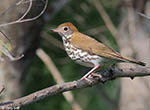 |
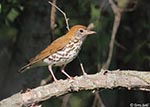 |
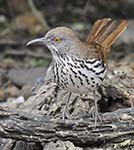 |
|
| Wood Thrush | Wood Thrush | Long-billed Thrasher |
Conservation Status:
Brown Thrashers are found across a very broad geographic area, and are common in many parts of that range. Populations overall are generally stable. The IUCN considers the Brown Thrasher to be a species of "Least Concern".
Further Information:
Photo Information:
May 13th, 2014 -- Brandon, South Dakota -- Terry Sohl
Additional Photos:
Click on the image chips or text links below for additional, higher-resolution Brown Thrasher photos.
Audio File Credits:
- 1Russ Wigh. Recorded in Chatham County, Georgia on March 10th, 2019. Original recording and information from xeno-canto.
- 2Antonio Xeira. Recorded in Hisle Park, Kentucky on July 10th, 2016. Original recording and information from xeno-canto.
- 3Ross Gallardy. Recorded in Adams County, Wisconsin on June 18th, 2016. Original recording and information from xeno-canto.
| Click on the map below for a higher-resolution view |
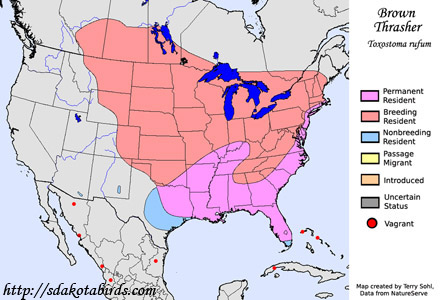 |
| South Dakota Status: Common summer resident |
Additional Brown Thrasher Photos
Click for a higher-resolution version of these photos
